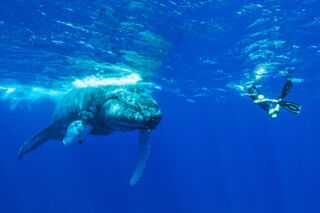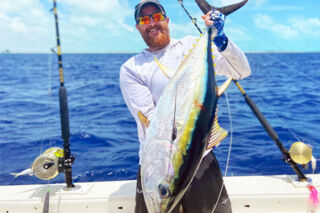Providenciales Whale Watching
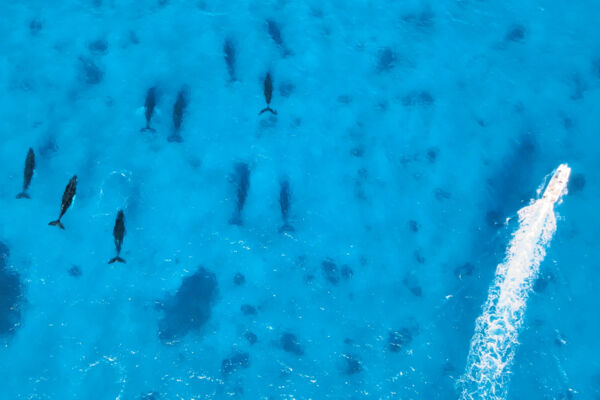
The Turks and Caicos is a great place for humpback whale watching. Whale watching tends to be a specialty charter activity on Providenciales, and is only available during the winter months.
Humpbacks are not the only aquatic marine mammals seen in the Turks and Caicos. Atlantic bottlenose dolphins are common sightings year-round, especially the famous JoJo the Dolphin. Pilot whales can also be seen in the deep blue water surrounding the islands.
Generally, there are no organized and dedicated whale watching charters from Providenciales. Encounters most often happen on snorkel and dive trips to Northwest Point, West Caicos, and Sandbore Channel, such as on Big Blue Collective’s extensive Edge of the Banks snorkel safari.
Humpback Whales in the Turks and Caicos
Every year, humpback whales undertake a migration from their normal domain of relatively cold waters to warmer waters to give birth and to mate.
The humpbacks that make the journey to the Turks and Caicos are thought to originate from Northern Hemisphere waters, including those off of north-western Europe, Greenland, Iceland, Canada, and from inside the Arctic Circle.
For many whales from this part of the world, their southernmost destination is the marine banks near the Turks and Caicos and the Dominican Republic, including the Silver Banks, Mouchoir Banks, and the isolated Gentry Banks.
Which Island Is Best for Whale Watching?
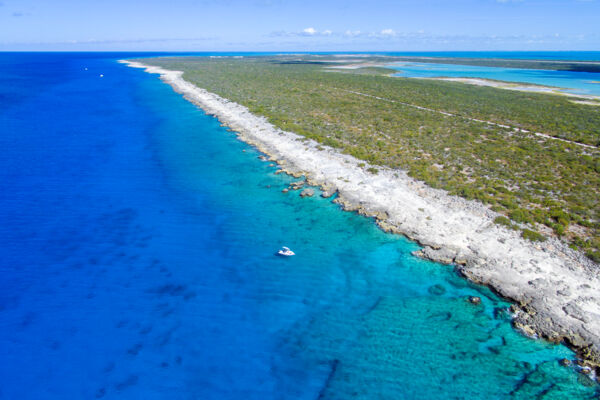
The Turks and Caicos has several populated islands, and whale watching conditions and the availability of charters varies greatly by island.

The remote and tiny island of Salt Cay is the best spot in the country for whale watching due to its ocean topography. The Turks Island Passage, the deep channel that separates the Turks Islands from the Caicos Islands, tends to funnel whales close to Salt Cay. Salt Cay is an amazing destination for whales, diving, and secluded beaches, yet doesn’t offer much more than that, and likely wouldn’t appeal to those seeking an active vacation.
Grand Turk, largely due to its close proximity to Salt Cay, also offers great whale watching conditions, and many of the local dive companies cater to whale watchers during the winter months.
Providenciales attracts by far the greatest number of visitors of any island in the Turks and Caicos, and has an impressive array of luxury accommodations. The western sides of Providenciales and West Caicos, including the waters off of the Northwest Point Marine National Park and the West Caicos Marine National Park, tend to offer the best chance of sightings.
The Whale Watching Season
Whale watching is one of the few activities in the Turks and Caicos that has a clearly defined season, with optimal sightings typically occurring between late January and the beginning of March.
The Atlantic humpback migration is a predictable event, yet the number of sightings does vary by year. During good years, whales are spotted almost every day and in-water encounters are common. Other years may not be quite as rewarding.
Snorkeling with Humpback Whales
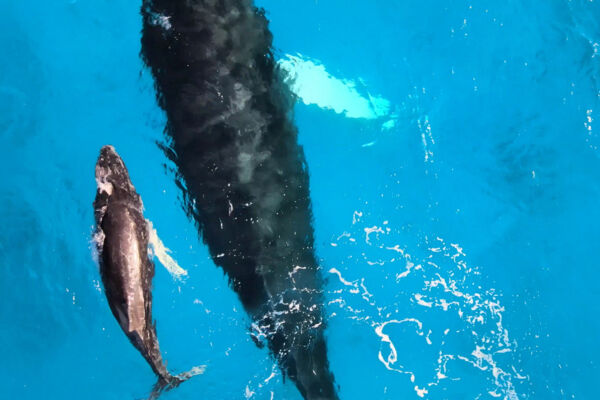
The Turks and Caicos is one of the few destinations where it’s feasible to snorkel with humpbacks (at least in non-freezing water!). Snorkeling encounters are certainly not guaranteed, yet the opportunity to do so often does occur.
In-water encounters are intended to be as low-impact to whales as possible. As is often the case, the boat will stop a distance from the humpbacks, snorkelers will enter the water, and the whales will approach or pass on their own.
As giving birth is one of the primary reasons the humpbacks make the long migration, it’s common to see calves. In some unforgettable encounters, whales and calves will spend time around the snorkelers, which in some cases has been longer than an hour!
Big Blue Collective, based in Leeward on Providenciales, is the primary whale watching excursion business. This eco-tour company specializes in small group snorkeling, diving, and charters, and has been pioneering whale watching from Providenciales for decades.
The whale watching season coincides with the peak ‘high season’ tourism arrivals in the Turks and Caicos, so the availability of charters may be limited. We advise booking well in advance.
Responsible Whale Watching Tips
As friendly as they can be, the humpback whales that migrate through the Turks and Caicos are, first and foremost, wild animals. The Turks and Caicos Department of Environment and Coastal Resources (DECR) has guidelines for interacting with marine mammals, such as dolphins and whales, in the islands. For the whales’ safety and for yours, it’s important to practice the following recommended behaviors when whale watching.
One of the benefits of whale watching in the Turks and Caicos is being able to get in the water with these majestic creatures. When snorkeling near a humpback whale:
- Avoid splashing your arms or legs excessively.
- Do not approach the whale—instead, let it approach you if it chooses to.
- Do not freedive into the whale's space.
- Do not try touching the whale, under any circumstances.
- Keep your distance from pregnant females to avoid being seen as a threat.
- If a marine mammal charges towards you, get out of the water immediately.
Whether you are in the water with a humpback whale or observing it from the deck of a tour boat, know that you should never litter in their environment or try to feed them. Feeding marine mammals is not only dangerous—it’s illegal under Turks and Caicos law.
Tour Companies
